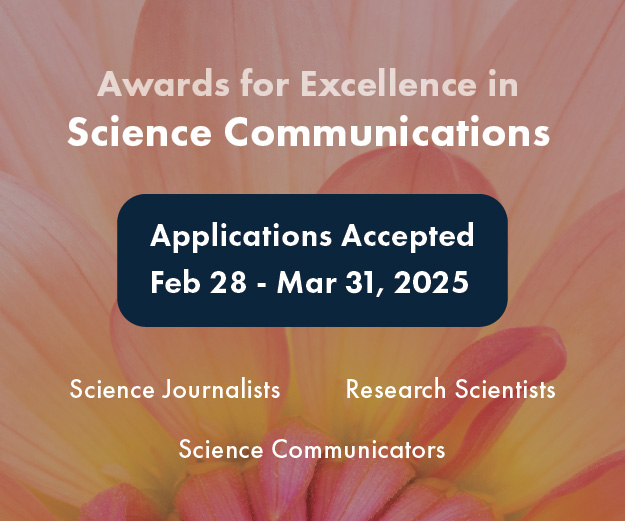By Natalie Jacewicz
From the puzzle of invasive beetles to the mystery of undiagnosed disease, ScienceWriters Awards Night celebrated the role of journalists as detectives. The year’s winners for excellent science writing — selected by the National Association of Science Writers and the Council for the Advancement of Science Writing — accepted awards at an Oct. 10 ceremony in Cambridge, Mass.
Judy Foreman received NASW’s book award for A Nation in Pain: Healing Our Biggest Health Problem, published by Oxford University Press in partnership with the International Association for the Study of Pain.“I got into writing this book the hard way — by suddenly coming down with excruciating neck pain,” explained Foreman. She wrote the book after overwhelming reader response to a column on chronic pain.
Foreman says “never stop reporting” on politicized topics. Information arms writers to distinguish between “the squishy parts and the solid parts” of opposing arguments.
Erik Vance won NASW’s science reporting award for “Why Nothing Works” from the July/August 2014 issue of Discover.
Vance suggests, “It’s helpful to know the story you don’t want to write” when covering nuanced science. In his article on placebos, Vance knew he wanted more nuance than a top-ten-things-placebos-can-do-for-you approach.
NASW’s long form reporting award honored “Big Oil, Bad Air” from InsideClimate News, Feb. 14, 2014. The Center for Public Integrity and The Weather Channel collaborated to investigate fracking’s impact on air quality. NASW identified Lisa Song, David Hasemyer, Jim Morris, and Greg Gilderman as recipients, but the award honors the piece’s entire reporting team.
Song said “huge collaboration” propelled the detective work. “It was a learning experience, and really fun. At some point, we would each tackle a single story together.”
Matthew Miller accepted NASW’s Local or Regional Market award for “Battle of the Ash Borer,” which appeared in the Lansing State Journal on Jul. 27, 2014. His article reads like a mystery.
The ash borer assisted. “I was lucky enough that the initial efforts to identify and understand the emerald ash borer had enough twist, turns, lucky breaks and dead ends to work as a detective story,” Miller says.
The Council for the Advancement of Science Writing also recognized two journalists for science writing excellence.
Madhumita Venkataramanan won the Evert Clark/Seth Payne Award for young journalists. The award recognized Venkataramanan’s Wired pieces — “My Identity for Sale” and “Welcome to BrainGate” — and her BBC piece “The Superpower Police Now Use to Tackle Crime.” Judges appreciated these “compelling and memorable narratives.”
Mark Johnson received the Victor Cohn Prize for excellent medical reporting. His newspaper, the Milwaukee Journal Sentinel, also received a special citation for sustained, exceptional reporting in medicine.
Judges say Johnson sculpts some of “medicine’s prevailing mysteries” into “pure pleasure” for readers. “Murray’s Problem” and “One in a Billion” exemplify Johnson’s detective narratives.
Though the winners vary widely, all likely ascribe to Vance’s summary of great science writing: “I want to be dazzled, and I want to be touched.”
What about mystery?
“I want a good twist at the end,” Vance says.



